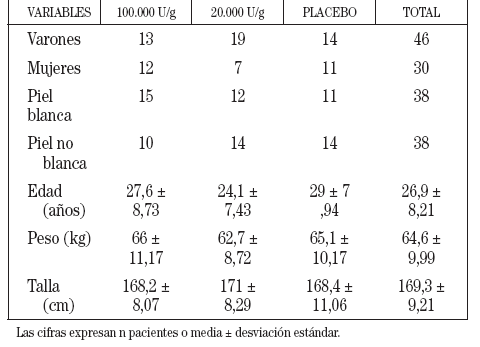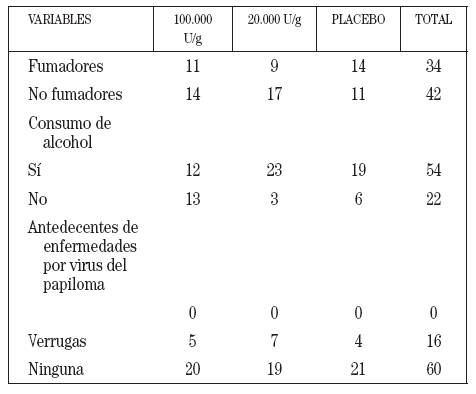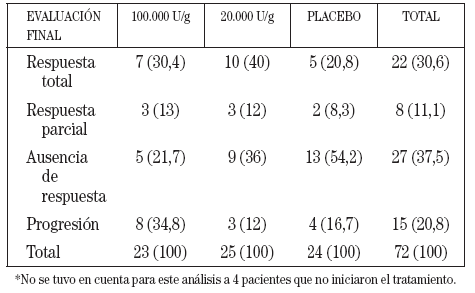ANTECEDENTES: El interferón alfa (IFNα) es una terapia aprobada para las lesiones causadas por el virus del papiloma humano (VPH).
PACIENTES Y MÉTODO: Se realizó un estudio a doble ciego, aleatorizado y controlado con placebo, en el que se incluyó a 76 pacientes infectados por el VPH que no presentaran más de cinco lesiones de condiloma acuminado. Los pacientes fueron tratados con una formulación tópica de IFNα leucocitario humano (nIFN) o con una formulación placebo, según correspondiera en la lista aleatorizada; 25 pacientes recibieron, cuatro veces al día durante 12 semanas consecutivas, una crema que contenía 100.000 U de nIFN/g (grupo I); 26, una crema de 20.000 I de nIFN/g (grupo II) y 26, la crema placebo (grupo III).
RESULTADOS: La asociación entre la evolución clínica de las lesiones y la respuesta al tratamiento mostró que 22 (30,6%) pacientes quedaron libres de lesiones, 7 (30,4%) del grupo I, 10 (40%) del grupo II y 5 (20,8%) del grupo III. Se produjo una disminución superior al 50% en el número y el tamaño de las lesiones en 3 (13%) pacientes del grupo I, 3 (12%) del grupo II y 2 (8,3%) del grupo III. Se consideró no respondedores a 5 (21,7%) pacientes del grupo I, 9 (23%) del grupo II y 13 (54,2%) del grupo III, pues tuvieron una disminución del número y el tamaño de las lesiones < 25%. Se definió como progresión un incremento > 25% del tamaño y el número de las lesiones, lo que se dio en 8 (34,8%) pacientes del grupo I, 3 (12%) del grupo II y 4 (16,7%) del grupo III.
CONCLUSIONES: Los 30 (41,7%) de 76 pacientes que en que desaparecieron o se redujeron el número y el tamaño de las lesiones son un resultado prometedor en el control de los condilomas acuminados empleando IFNα en crema.
BACKGROUND: Interferon-alpha (IFNα) is an approved treatment for genital lesions caused by human papilloma virus (HPV).
PATIENTS AND METHOD: We performed a randomized, double-blind, placebo-controlled study in 76 patients infected with HPV and with no more than five condyloma acuminate lesions who were treated with a topical formulation of human leukocyte interferon alpha (nIFN) or placebo according to the randomization. Twenty-five patients received a cream containing 100,000 UI/g of nIFN (group I), 26 a cream containing 20,000 UI/g nIFN (group II) and 26 received a placebo cream (group III), four times daily for 12 weeks.
RESULTS: The association between the clinical course of the lesions and treatment response showed 22 patients without lesions (30.6%): 7 in group I (30.4%), 10 in group II (40%) and five in group III (20.8%). A decrease of more than 50% in the number and size of the lesions occurred in three patients in group I (13%), three patients in group II (12%) and two in group III (8.3%). Five patients in group I (21.7%), nine in group II (23%) and thirteen in group III (54.2%) were considered non-responders because the decrease was less than 25%. An increase of more than 25% was defined as progression and was found in eight patients in group I (34.8%), three in group II, and four in group III (16.7%).
CONCLUSIONS: The finding that 30/76 (41.7%) patients showed disappearance or reduction in the number and size of their lesions suggests that IFN-alpha cream may be a promising alternative in the treatment of condyloma acuminate.
Artículo
Comprando el artículo el PDF del mismo podrá ser descargado
Precio 19,34 €
Comprar ahora








